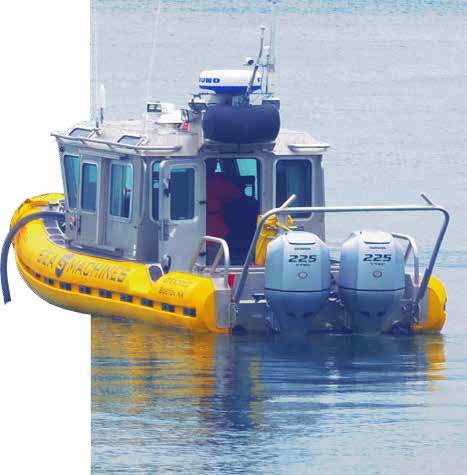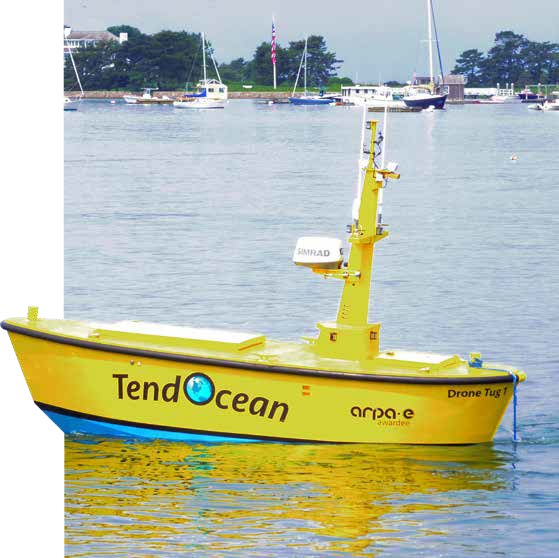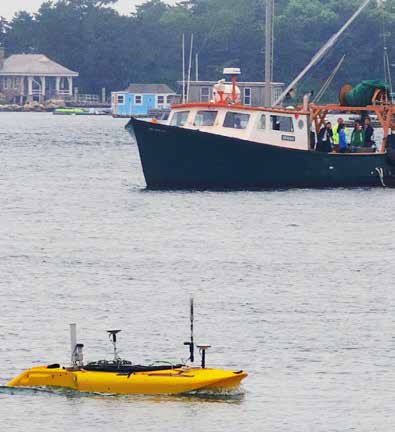Press & Media
In The News.

In The News.
By Brian Sprowl
The United States currently enjoys a significant advantage in the undersea realm, but according to Christine Fox, senior adviser at the Johns Hopkins University Applied Physics Laboratory, it is “absolutely the focus of competition and it is critically important from a national security perspective that we not get complacent, especially since this is one of the best deterrents that we have from any kind of hostility in the world.”
For Fox, maintaining this advantage is a matter of creativity. “We need more, and we need more innovation in this realm,” Fox, who previously served as the acting deputy secretary of defense, said during the 5th Annual Entrepreneur Forum in Woods Hole, Massachusetts in mid-July. "I think that unmanned underwater vehicles are really a key to this, and I do believe that the department is waking up to that fact,” she said.
According to Mike Smitsky, AUVSI's manager of advocacy and government relations, maintaining this advantage will also require the U.S. Navy continuing to prioritize unmanned maritime systems (UMS) programs in its annual budget requests. Smitsky, who also manages and staffs AUVSI's UMS Advocacy Committee, notes that in fiscal year 2020, the Navy requested several funding increases for UUV programs, but that is just the start of a much longer process. “These ambitious requests demonstrate leadership recognition that UUVs are critical to both the security of the country and the future complexion of the Naval fleet architecture. However, the battle does not end here. These requests must be authorized and appropriated,” he says.
Both the National Defense Authorization Act and the Defense Appropriations Act need to match the initial budget requests to materialize the Navy's vision. While the final product does not always match the initial requests, the UMS Advocacy Committee can help in this process by educating House and Senate offices who sit on the Armed Services and Appropriations committees on the significance of UMS to the future of the Navy.
“This process of consistently raising awareness about the importance of UMS technologies to the security of the nation ideally will help appropriations mirror the initial request by the Navy,” he says. He adds it is important to effectively articulate what the Navy's overall intent is with these programs, because if congress doesn't understand the context, it won't fund these programs. With the Navy being such a large entity with so much on its plate, the UMS Advocacy Committee wants to help inform the Navy of industries' positions, to help the U.S. maintain its advantage.
“By meeting with department leaders who prioritize UMS, the committee can act as an industry liaison and provide an external viewpoint on concepts like acquisition strategy, autonomy export controls, cybersecurity, and IT infrastructure,” Smitsky says. “As a result, industry can act as an accelerant and help the Navy adjust their focus where necessary.” Commercially, unmanned vehicles and robotics have the potential to impact a number of industries such as oil and gas, energy and aquaculture.
From a commercial integration standpoint, one of the biggest hurdles are the COLREGs. Traditionally, these set of regulations provide the “rules of the road” for vessels to prevent collisions, but due to the increased presence of UMS, COLREGs require “substantial updating,” Smitsky says.
 During the 5th Annual Entrepreneur Forum in Woods Hole, Massachusetts, Sea Machines demonstrated its autonomous vessel. All Photos: AUVSI
During the 5th Annual Entrepreneur Forum in Woods Hole, Massachusetts, Sea Machines demonstrated its autonomous vessel. All Photos: AUVSI
The rules are published by the International Maritime Organization (IMO), which recently met to discuss autonomous vessel integration and COLREGs. The U.S. representative on the IMO is the United States Coast Guard, which has previously received industry input on what these updated rules should take into consideration. Other pieces of legislation include the Commercial Engagement Through Ocean Technology (CENOTE) Act of 2018, and the Coast Guard Authorization Act of 2019, which the U.S. House of Representatives approved in late July. The bill moved to Senate at the time of publishing. Signed into law Dec. 21, 2018, the CENOTE Act of 2018 encourages partnerships between academia, the private sector, and the government in the realm of ocean observation. The CENOTE Act of 2018 authorizes the Department of Commerce's National Oceanic and Atmospheric Administration (NOAA) to “evaluate the use of unmanned maritime system technology for use in data collection.”
Meanwhile, the Coast Guard Authorization Act of 2019 (CGAA 2019) is legislation that “reauthorizes appropriations for the Coast Guard and Federal Maritime Commission through Fiscal Year 2021.” The bill also includes “regulatory improvements to promote the U.S. maritime industry and offshore renewable energy development, ongoing authorization of funding to build new polar security cutters (heavy ice breakers), new requirements for the Coast Guard to assess and evaluate unmanned technologies for potential use in Coast Guard operations, provisions to increase diversity at the U.S. Coast Guard Academy, and new maritime safety enhancements.” AUVSI's UMS Advocacy Committee played an influential role on section 416 of this bill, which “directs the Commandant of the Coast Guard to develop a plan for a demonstration program that will assess the feasibility of using unmanned maritime systems for surveillance of marine protected areas and to submit a report to Congress on that plan.” “Both of these bills are legislative vehicles that provide additional authorities for NOAA and the USCG to deploy UMS technology,” Smitsky says.
 Tend Ocean demonstrates its Drone Tug during the 5th Annual Entrepreneur Forum.
Tend Ocean demonstrates its Drone Tug during the 5th Annual Entrepreneur Forum. Woods Hole Oceanographic Institution demonstrates its JetYak Remote Surface Vehicle during the 5th Annual Entrepreneur Forum.
Woods Hole Oceanographic Institution demonstrates its JetYak Remote Surface Vehicle during the 5th Annual Entrepreneur Forum.